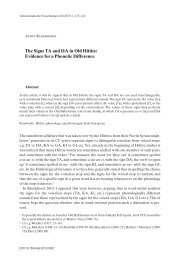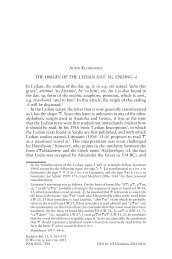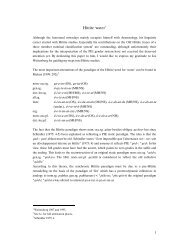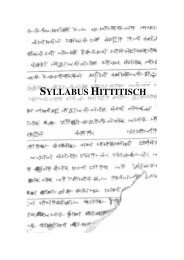Indo-European Nominal Ablaut Patterns - Alwin Kloekhorst ...
Indo-European Nominal Ablaut Patterns - Alwin Kloekhorst ...
Indo-European Nominal Ablaut Patterns - Alwin Kloekhorst ...
You also want an ePaper? Increase the reach of your titles
YUMPU automatically turns print PDFs into web optimized ePapers that Google loves.
now through analogical developments introduced in an unstressed syllable or secondarily loses its<br />
stress, it does not become *o anymore, but remains *e.]<br />
“F. rise of lengthened grade vowels *ē and *ō, yielding the conventional Proto-<strong>Indo</strong>-<strong>European</strong> vowel<br />
system.” [Only in certain specific positions, namely in monosyllabic words (e.g. diḗus) and in wordfinal<br />
position before a resonant (e.g. *ph2tḗr), original short *e and *o are phonetically lenghtened to<br />
*ē and *ō (Kortlandt 1975: 85, going back to Wackernagel 1896: 66f.). 32 This means that *ē and *ō<br />
did not belong to the original ablaut patterns.]<br />
This chronology of developments can explain certain phenomena that thus far remained unexplained,<br />
for instance, the development of neuter s-stems. Since Schindler 1975b, it is commonly accepted that<br />
neuter s-stems originally had the proterodynamic shape *CéC-s, *CC-és-s, but were later on reshaped<br />
to *CéC-os, *CéC-es-os:<br />
nom.-acc.sg. *mén-s >> *mén-os<br />
gen.sg. *mn-és-s >> *mén-es-os<br />
Schindler (1975b: 266) could not explain the origin of *-o- in *mén-os, however: “Eine sichere<br />
Deutung der o-Qualität [of mén-os] läßt sich freilich nicht geben, und ich verzichte auf Spekulationen<br />
darüber”. In the light of Beekes-Kortlandt’s chronology above, this and the other forms of the<br />
paradigm can now be explained in the following way. We first have to assume that at stage C, i.e. the<br />
stage in which an unaccented *e automatically turned into *o, “[*ménos] arose when -es- from the<br />
oblique cases was introduced into the nominative” (Beekes 1985: 158).<br />
nom.-acc.sg. *mén-s >> *mén-os<br />
gen.sg. *mn-és-s = *mn-és-s<br />
dat.sg. *mn-és-i = *mn-és-i<br />
At the same time, the hysterodynamic gen.sg. ending *-és was introduced in order to keep the genitive<br />
recognizable as such “da idg. /ss/ [in *mn-és-s] als [s] realisiert wurde und somit der Genitiv<br />
phonetisch nicht mehr durch eine Endung charakterisiert war” (Schindler 1975b: 264). Since this<br />
ending became unaccented, its vowel *-e- automatically turned into *-o-.<br />
nom.-acc.sg. *mén-os = *mén-os<br />
gen.sg. *mn-és-s >> *mn-és-os<br />
dat.sg. *mn-és-i = *mn-és-i<br />
Later on, at stage D, 33 when *e and *o had become distinct phonemes, the full grade of the root was<br />
generalized. 34<br />
32<br />
This is the reason why introduction of the accusative stem *ph2-tér- (with short *é) into the nominative case<br />
yielded *ph2-tḗr with long *ḗ, cf. section 6.<br />
33 w<br />
For Latin iecur, iocineris ‘liver’ we must assume that in the original proterodynamic paradigm *iék -r,<br />
*ik w -én-, the full grade of the root spread through the paradigm at stage C already. In this way, the unaccented<br />
full grade root automatically turned into *-o-, yielding *iék w -r, *iok w -én-, which eventually developed into Lat.<br />
iecur, iocineris.<br />
34<br />
On the basis of e.g. Skt. mánas, mánasas and Gr. µένος, µένεος the PIE paradigm is usually reconstructed as<br />
*ménos, *ménesos. Yet, if HLuw. tipas- ‘heaven’ indeed reflects *neb h és- (thus Hajnal 1995: 63), which<br />
contrasts with CLuw. tappaš- ‘heaven’ that reflects *néb h e/os-, we must assume that in Proto-Luwic, and, by<br />
extension, in Proto-Anatolian, neuter s-stems still showed a mobile accentuation, *CéC-os, *CeC-és-os (cf.<br />
<strong>Kloekhorst</strong> 2008: 604). This mirrors the situation in Slavic, where s-stems (e.g. OCS nebo ‘heaven’) inflect<br />
according to accent paradigm c, which points to an earlier mobile accentation as well (as kindly pointed out to<br />
me by Frits Kortlandt). Moreover, Kroonen (2007) argued that on the basis of e.g. Lat. imber ‘rain’ and Arm.<br />
8






